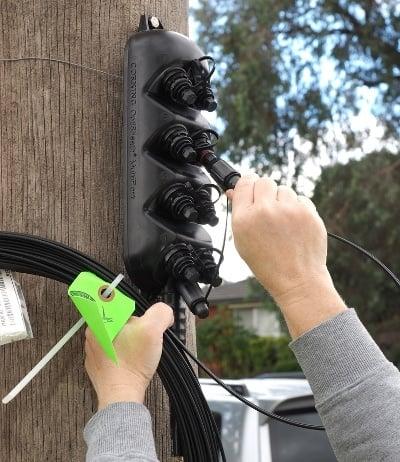Choosing the Right Optical Fiber: A Manufacturer’s Guide to ITU-T G.65x Standards
Summary: Selecting the correct optical fiber standard is fundamental to network performance, cost, and future scalability. This guide explains the most important ITU-T G.65x fiber types—G.652, G.657, and G.655—to help you make an informed decision for your project, whether it’s a long-haul backbone or a final FTTH drop.
The Role of ITU-T Standards
In the world of fiber optics, not all glass is created equal. The core of every cable—the optical fiber itself—is engineered to specific standards defined by the International Telecommunication Union (ITU-T). These standards, known as the G.65x series, dictate everything from a fiber’s light-carrying properties to its ability to handle physical stress. As a leading manufacturer exporting to over 130 countries, ZTO Cable leverages these standards to produce high-performance cables optimized for every application.
G.652: The Universal Standard for Backbone Networks
G.652, or standard single-mode fiber (SMF), is the most widely deployed optical fiber in the world. It is the workhorse for long-haul, metro, and access network backbones. While there are four subcategories (A, B, C, D), the modern industry standard is G.652D.
- Key Feature: G.652D is a low-water-peak fiber. This means the high attenuation around the 1383 nm wavelength (the “water peak”) has been eliminated, opening it up for use across the entire 1310 nm to 1550 nm spectrum and making it suitable for Coarse Wavelength Division Multiplexing (CWDM) applications.
- Best For: Any application requiring reliable, long-distance transmission where extreme bending is not a primary concern.
- ZTO Products: G.652D fiber is the core component in our Duct FO Cables like GYTS and Aerial FO Cables like ADSS, designed for robust outdoor infrastructure.
G.657: Bend-Insensitive Fiber for FTTH and Access Networks
G.657, or bend-insensitive fiber (BIF), is a crucial innovation for expanding fiber networks into homes and offices. Its design allows it to be bent and stapled around sharp corners with minimal signal loss—something that would critically degrade a G.652 fiber.
This flexibility makes installations faster, cheaper, and more reliable in confined spaces. The standard is divided into categories A and B, with further sub-divisions (e.g., A1, A2, B3) denoting increasingly better bend performance.
- Key Feature: Extremely low macro-bending loss. For example, G.657.A2 fiber can be coiled with a radius as small as 7.5 mm, making it perfect for indoor wiring.
- Best For: Fiber-to-the-Home (FTTH), data centers, and dense enterprise environments.
- ZTO Products: Our FTTH Drop Cables almost exclusively use G.657.A1 or G.657.A2 fiber to ensure seamless last-mile connectivity for our clients.
G.655: The Choice for High-Capacity DWDM Systems
G.655 is a non-zero dispersion-shifted fiber (NZDSF). It was specifically developed to overcome the limitations of older G.653 fiber in Dense Wavelength Division Multiplexing (DWDM) systems. While G.653 had zero dispersion at 1550 nm, this caused severe non-linear effects like Four-Wave Mixing (FWM), which corrupts data channels.
G.655 cleverly shifts the zero-dispersion point outside the 1550 nm operating window, maintaining a small, controlled amount of chromatic dispersion. This is enough to suppress FWM while being low enough to not require significant dispersion compensation.
- Key Feature: Manages chromatic dispersion to support dozens or hundreds of high-speed data channels over long distances.
- Best For: Long-haul and ultra-long-haul DWDM networks that form the backbone of the internet.
A Quick Comparison of Key Fiber Types
| Fiber Standard | Common Name | Primary Application | Key Advantage |
|---|---|---|---|
| G.652D | Standard SMF (Low Water Peak) | Metro, Long-Haul, Backbone | Cost-effective, versatile, CWDM-ready. |
| G.657A2 | Bend-Insensitive Fiber (BIF) | FTTH, Data Center, Indoor | Excellent performance in tight spaces and around corners. |
| G.655 | NZDSF | DWDM Long-Haul Networks | Suppresses non-linear effects for high channel counts. |
| G.654 | Cut-off Shifted Fiber | Submarine / Undersea Cables | Ultra-low loss and large effective area for transoceanic distances. |
Note: Other standards like G.653 are now largely obsolete, while G.656 is designed for even broader wavelength DWDM systems. G.654 remains a specialized standard primarily for subsea projects due to its higher cost.
Conclusion: Partner with an Expert Manufacturer
Choosing the correct fiber standard is the foundation of a high-performing and reliable optical network. For most terrestrial applications, the decision comes down to G.652D for backbone infrastructure and G.657 for the final connection to the user. At ZTO Cable, our fully integrated production chain—from drawing optical fiber to manufacturing finished cables—ensures that every product adheres strictly to IEC 60794 and the relevant ITU-T standards.

